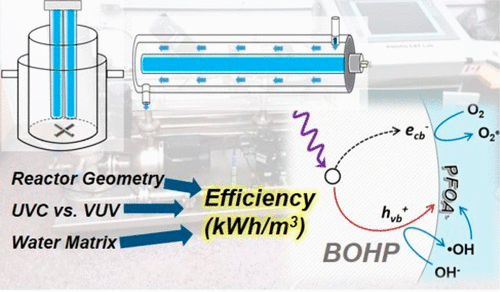当前位置:
X-MOL 学术
›
ACS ES&T Eng.
›
论文详情
Our official English website, www.x-mol.net, welcomes your feedback! (Note: you will need to create a separate account there.)
Impacts of Reactor Configuration, Degradation Mechanisms, and Water Matrices on Perfluorocarboxylic Acid Treatment Efficiency by the UV/Bi3O(OH)(PO4)2 Photocatalytic Process
ACS ES&T Engineering Pub Date : 2020-11-16 , DOI: 10.1021/acsestengg.0c00086 Mojtaba Qanbarzadeh 1 , Dawei Wang 1 , Mohamed Ateia 2 , Sushant P. Sahu 3 , Ezra L. Cates 1
ACS ES&T Engineering Pub Date : 2020-11-16 , DOI: 10.1021/acsestengg.0c00086 Mojtaba Qanbarzadeh 1 , Dawei Wang 1 , Mohamed Ateia 2 , Sushant P. Sahu 3 , Ezra L. Cates 1
Affiliation

|
Semiconductor photocatalysis is currently being explored as a treatment tool for wastewaters contaminated with poly-/perfluoroalkyl substances (PFAS), such as groundwater impacted by aqueous film-forming foams. While numerous catalysts have been shown to degrade perfluorocarboxylic acids (PFCAs) such as PFOA, research thus far has been confined to bench-scale evaluations that offer little insight into the practical aspects and potential energy efficiency expected during full-scale application. Herein, we advanced such understanding using the recently discovered Bi3O(OH)(PO4)2 catalyst system (UV/BOHP) by first elucidating the basic PFCA degradation mechanisms and behavior, followed by comparisons among different photoreactor designs. The BOHP suspension degraded PFCAs primarily through direct heterogeneous oxidation by valence band holes, and kinetics correlated positively with chain length. Degradation of PFCAs was further compared between stirred immersion photoreactors, bench-scale confined-flow high-intensity slurry photocatalytic reactors (CHISPRs), and a larger commercial CHISPR system. Complete degradation (>99%) of long-chain PFCAs was observed in the immersion reactors within 60 min, while the CHISPRs degraded all PFAS tested within 20 min; however, control tests revealed that direct photolysis by vacuum UV was the main driver in the CHISPRs. Despite their faster kinetics, the energy consumption (per order removal) of PFOA photolysis in the unmodified CHISPRs was significantly higher (51–124 kWh/m3) compared to PFOA photocatalysis in the immersion reactors (25 ± 4 kWh/m3). Based on these findings, practical photoreactor design criteria were proposed which incorporate both photolysis and photocatalysis, and which have implications beyond just the UV/BOHP process.
中文翻译:

UV / Bi 3 O(OH)(PO 4)2光催化工艺对反应器构型,降解机理和水基质对全氟羧酸处理效率的影响
半导体光催化技术目前正被用作一种处理工具,用于处理被聚/全氟烷基物质(PFAS)污染的废水,例如受成膜水泡沫影响的地下水。尽管已显示出许多催化剂可降解全氟羧酸(PFCA),例如PFOA,但迄今为止,研究仅限于基准规模的评估,这些评估对实际应用和全面应用过程中预期的潜在能源效率了解甚少。在本文中,我们使用最近发现的Bi 3 O(OH)(PO 4)2促进了这种理解。催化剂系统(UV / BOHP),首先阐明基本的PFCA降解机理和行为,然后比较不同光反应器设计之间的比较。BOHP悬浮液主要通过价带孔的直接异质氧化作用降解了PFCA,动力学与链长呈正相关。进一步比较了搅拌浸没光反应器,台式规模密闭流高强度浆料光催化反应器(CHISPR)和更大的商用CHISPR系统之间PFCA的降解。在浸入式反应器中,在60分钟内观察到长链PFCA完全降解(> 99%),而CHISPR在20分钟内降解了所有测试的PFAS。然而,对照测试表明,真空紫外线直接光解是CHISPRs的主要驱动力。尽管动力学更快,3)与浸入式反应器(25±4 kWh / m 3)中的PFOA光催化相比。基于这些发现,提出了实用的光反应器设计标准,该标准同时包含了光解和光催化作用,其含义不仅仅限于UV / BOHP工艺。
更新日期:2020-11-16
中文翻译:

UV / Bi 3 O(OH)(PO 4)2光催化工艺对反应器构型,降解机理和水基质对全氟羧酸处理效率的影响
半导体光催化技术目前正被用作一种处理工具,用于处理被聚/全氟烷基物质(PFAS)污染的废水,例如受成膜水泡沫影响的地下水。尽管已显示出许多催化剂可降解全氟羧酸(PFCA),例如PFOA,但迄今为止,研究仅限于基准规模的评估,这些评估对实际应用和全面应用过程中预期的潜在能源效率了解甚少。在本文中,我们使用最近发现的Bi 3 O(OH)(PO 4)2促进了这种理解。催化剂系统(UV / BOHP),首先阐明基本的PFCA降解机理和行为,然后比较不同光反应器设计之间的比较。BOHP悬浮液主要通过价带孔的直接异质氧化作用降解了PFCA,动力学与链长呈正相关。进一步比较了搅拌浸没光反应器,台式规模密闭流高强度浆料光催化反应器(CHISPR)和更大的商用CHISPR系统之间PFCA的降解。在浸入式反应器中,在60分钟内观察到长链PFCA完全降解(> 99%),而CHISPR在20分钟内降解了所有测试的PFAS。然而,对照测试表明,真空紫外线直接光解是CHISPRs的主要驱动力。尽管动力学更快,3)与浸入式反应器(25±4 kWh / m 3)中的PFOA光催化相比。基于这些发现,提出了实用的光反应器设计标准,该标准同时包含了光解和光催化作用,其含义不仅仅限于UV / BOHP工艺。


























 京公网安备 11010802027423号
京公网安备 11010802027423号